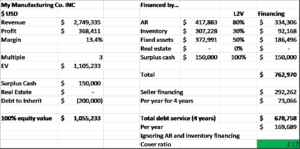
Manufacturing is one of the largest sectors in the world. In the U.S. alone, IBISWorld reports it’s a $5.6 trillion market that’s only getting bigger…
According to the National Association of Manufacturers, U.S. manufacturing exports have quadrupled in the past 28 years, representing 50% of all output. And they project 4.6 million new manufacturing jobs will be created in the next 10-years.
Given its sheer size, the manufacturing sector covers a LOT of different areas. Not to mention, there are three primary types of manufacturing…
And multiple sub-sectors, such as:
(Just to name a few.)
Manufacturing also overlaps with engineering, aerospace, technology and medical devices.
Beyond the diversity in the sector, there are some other GREAT attributes about manufacturing businesses that make them good leveraged buyout (LBO) deal candidates…
Owners
First of all, the majority of manufacturing businesses are owned by baby boomers, many of who will retire in the next 10 years. These sellers value legacy and the protection of their employees and business culture. Knowing this can set your negotiations up for success.
Asset-Rich
By nature, manufacturing businesses contain lots of fixed assets (equipment) and working capital assets (cash, inventory and accounts receivable). You can use ALL of these to finance a closing payment.
Little to No Marketing
Additionally, most small manufacturing businesses live off repeat business and word-of-mouth referrals. They don’t do a lot of marketing to keep the business growing at a slow but steady tick.
I LOVE buying these kinds of businesses because once you implement some marketing strategies, the business will grow quickly beyond the solid revenue base you inherit.
Loyal People
Manufacturing businesses also tend to attract steady, stable and loyal employees, resulting in low staff turnover. Therefore, you will typically have some great candidates for GM. This will allow you as the new owner to work ON the business versus IN the business.
Longevity
Finally, 96% of all small businesses fail within the first 10 years. Yet the average manufacturing business has been around for longer. This is a sector that’s far more resilient compared with hospitality, retail and professional services, for example.
Potential Downsides
Manufacturing is not all fun and games. One issue is the threat of low-cost imports, especially from China. You need to make sure you buy a business that doesn’t compete on price alone.
Find a business that offers a good level of service (loyal customers will prove that), or some differentiation in its design, production, delivery, etc.
Another possible issue for U.K. deals in particular is the Brexit impact. U.K. manufacturers export a lot to the EU, and this has become messier since Brexit. Though it’s still definitely possible, trade now involves more regulation and cost. Just be mindful of this in the U.K.
But overall, manufacturing is still a solid sector for LBOs. It’s diverse, stable and typically asset-rich with high levels of workforce loyalty.
In fact, in a recent Dealmaker Academy group coaching session, we reviewed a furniture manufacturer that sold 100% through retailers, nothing online. (Hint: Big growth opportunity there.)
Here’s a quick look at the numbers…

The business is generating just under $2.8 million in revenue at a 13.4% EBITDA margin and generating $368,411 in profit.
At a 3X multiple — adjusting for the $150K surplus cash and the $200K bank loan we will inherit — we are paying $1.06 million for the business.
Using asset financing, you can leverage the AR, inventory and fixed assets on this deal. (I’ll explain more about asset-based lending in my next article, so stay tuned.)
And the $150K of surplus cash can also be used as part of the closing payment.
Since total financing nets $762,970, we can make a $700K closing payment. The remaining $63K can be reserved to cover closing costs and top up working capital.
Seller financing will therefore be just a touch under $300K, payable over four years.
Ignoring the repayment of capital for the inventory and AR facilities (these are revolving lines of credit the business will continue to use as it trades going forward), we will need to repay $678K and change over a four-year period, just shy of $170K per year.
The current profit of $368,411 gives us a cover ratio of 2.17 — well more than the 1.5 minimum I recommend. It’s a sound deal target, pending due diligence.
With so many sub-niches and variations, manufacturing remains a very strong sector for LBOs. The businesses are typically boomer-owned, asset-rich and do little to no marketing. These are solid opportunities.
Until next time, bye for now.
